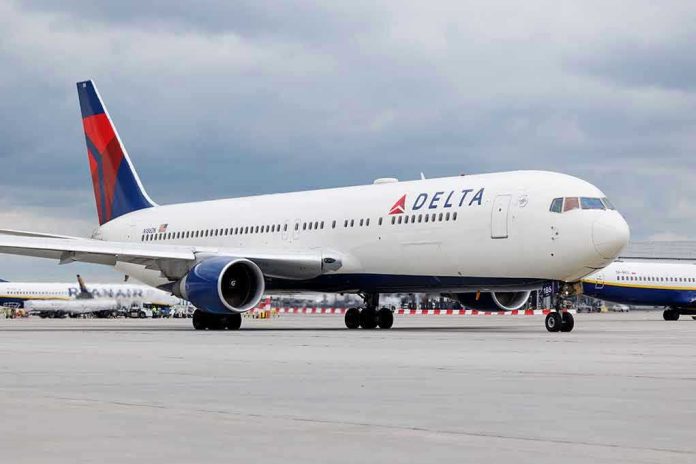
A Delta flight’s 2,000-mile diversion raises questions about airline safety protocols.
Story Highlights
- Delta Flight 389 diverted to Los Angeles due to a pilot’s illness.
- The diversion added approximately 8 hours to the journey.
- Safety protocols ensured a safe landing and crew replacement.
- Incident underscores the importance of robust contingency planning.
Delta Flight 389’s Emergency Detour
Delta Air Lines Flight 389, en route from Detroit to Shanghai, was forced to make an unexpected 2,000-mile diversion to Los Angeles after one of the pilots fell ill. On this August 2025 flight, the Airbus A350 was five hours into its journey when the incident occurred near Juneau, Alaska. The crew decided to divert to LAX, a major Delta hub, optimizing for operational continuity and crew replacement. This decision reflects Delta’s commitment to passenger safety amid unforeseen challenges.
The diversion added significant travel time, resulting in an eight-hour delay to the flight’s final destination in Shanghai. Passengers faced a 3.5-hour ground wait at LAX as the crew was replaced. Despite the inconvenience, Delta’s swift action ensured the safety of both passengers and crew. The incident highlights the critical need for contingency planning on international routes, especially those over remote areas with limited diversion options.
Operational Decisions and Protocols
The decision to divert to Los Angeles instead of the closest airport was strategic, given Delta’s extensive resources at LAX. The airport’s capacity to support crew swaps and provide necessary maintenance made it the optimal choice, despite the longer detour. This incident underscores the importance of having robust safety and operational protocols, which Delta promptly executed, ensuring a safe and efficient resolution to an unpredictable situation.
Historically, long-haul flights over remote regions necessitate comprehensive planning due to sparse infrastructure and challenging weather. The increased frequency of ultra-long-haul flights has heightened focus on crew health and redundancy. This diversion is reminiscent of previous incidents, like Delta Flight DL275’s diversion due to technical issues earlier in 2025, emphasizing the ongoing operational risks in commercial aviation.
Industry Implications and Future Considerations
While passengers were inconvenienced, Delta’s handling of the situation reinforces the value of hub airports for operational resilience. The economic implications include additional fuel costs and potential compensation for delayed passengers. Such incidents may prompt airlines to review crew health protocols and diversion strategies for remote routes. Aviation experts advocate for enhanced health monitoring and psychological support for crew members on ultra-long-haul flights.
"Delta flight takes 2,000-mile detour after pilot fell ill — adding 8 hours to journey
The plane, five hours into the trip, was just south of Alaska when the crew decided to divert to Delta’s hub in Los Angeles — a three-hour flight south and west. https://t.co/wFDBF8QOVt
— Sukhi jeevan parash🇮🇳मोदी का परिवार (@JeevanSukhi) September 2, 2025
In conclusion, Delta’s handling of Flight 389’s emergency diversion demonstrates the importance of readiness and strategic decision-making in aviation. This incident serves as a reminder of the complexities of ensuring safety and operational continuity in the face of unexpected challenges, reinforcing the industry’s need for continuous improvement in safety protocols and contingency planning.



